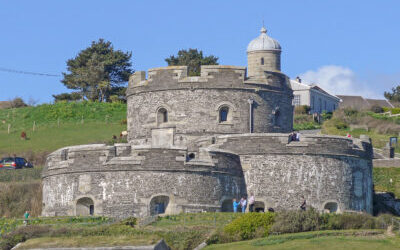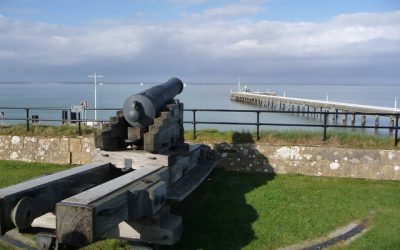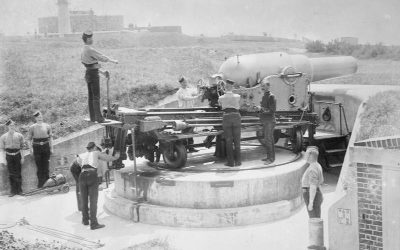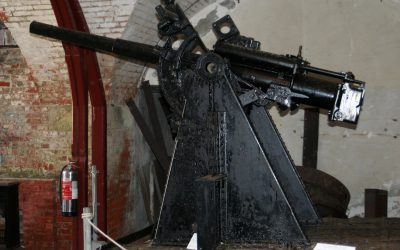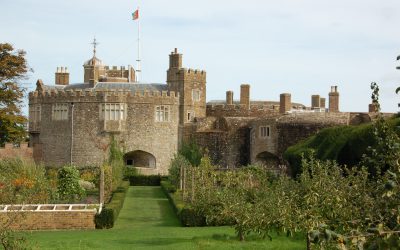The Device Forts, also known as Henrician castles and blockhouses, were a series of artillery fortifications built to defend the coast of England and Wales by Henry VIII. Traditionally, the Crown had left coastal defences in the hands of local lords and communities but the threat of French and Spanish invasion led the King to issue an order, called a “device”, for a major programme of work between 1539 and 1547.
The fortifications ranged from large stone castles positioned to protect the Downs anchorage in Kent, to small blockhouses overlooking the entrance to Milford Haven in Pembrokeshire, and earthwork bulwarks along the Essex coast. Some forts operated independently, others were designed to be mutually reinforcing. The Device programme was hugely expensive, costing a total of £376,000; much of this was raised from the proceeds of the dissolution of the monasteries a few years before.
These utilitarian fortifications were armed with artillery, intended to be used against enemy ships before they could land forces or attack ships lying in harbour. The first wave of work between 1539 and 1543 was characterised by the use of circular bastions and multi-tiered defences, combined with many traditional medieval features. These designs contained serious military flaws, however, and the second period of construction until 1547 saw the introduction of angular bastions and other innovations probably inspired by contemporary thinking in mainland Europe. The castles were commanded by captains appointed by the Crown, overseeing small garrisons of professional gunners and soldiers, who would be supplemented by the local militia in an emergency.
Despite a French raid against the Isle of Wight in 1545, the Device Forts saw almost no action before peace was declared in 1546. Some of the defences were left to deteriorate and were decommissioned only a few years after their construction. After war broke out with Spain in 1569, Elizabeth I improved many of the remaining fortifications, including during the attack of the Spanish Armada of 1588. By the end of the century, the defences were badly out of date and for the first few decades of the 17th century many of the forts were left to decay.
Most of the fortifications saw service in the First and Second English Civil Wars during the 1640s and were garrisoned during the Interregnum, continuing to form the backbone of England’s coastal defences against the Dutch after Charles II was restored to the throne in 1660. Again left to fall in ruin during the 18th century, many of the Device Forts were modernised and rearmed during the Napoleonic Wars, until peace was declared in 1815.
Fears over a possible French invasion resurfaced several times in the 19th century, combined with rapid changes in technology, such as the development of steamships and shell guns in the 1840s, rifled cannon and iron-clad warships in the 1850s, and torpedo boats in the 1880s. This spurred fresh investment in those Device Forts still thought to be military valuable, and encouraged the decommissioning of others.
By 1900, however, developments in guns and armour had made most of the Device Forts that remained in service simply too small to be practical in modern coastal defence. Despite being brought back into use during the First and Second World Wars, by the 1950s the fortifications were finally considered redundant and decommissioned for good. Coastal erosion over the centuries had taken its toll and some sites had been extensively damaged or completely destroyed. Many were restored, however, and opened to the public as tourist attractions.
Bibliography
Attribution
The text of this page was adapted from “Device Forts” on the English language website Wikipedia, as the version dated 30 July 2018, and accordingly this page is licensed under CC BY-SA 3.0. Principle editors have included Hchc2009, 157.203.42.132 and Nev1, and the contributions of all editors can be found on the history tab of the Wikipedia article.
Photographs on this page are drawn from the Wikimedia website, as of 22 July 2018, and attributed and licensed as follows: “Kingswear Castle, closeup“, author Nilfanion, released under CC BY-SA 3.0; “Hans Holbein, the Younger, Around 1497-1543 – Portrait of Henry VIII of England” (Public Domain); “Calshot castle evening“, author Geni, released under CC BY-SA 3.0; “St Mawes Castle (26259837935)“, author Tim Green, released under CC BY-SA 2.0; “Yarmouth Castle, Isle of Wight“, author Christine Matthews, released under Map of Brownsea Castle“, author Hchc2009, released under CC BY -SA 4.0; “Cowdray Engaving-detail of sinking” (Public Domain); “Artillery gun at Yarmouth Castle“, author Chris Downer, released under Symonds and Co Collection Q41377“, Imperial War Museums, released under the IWM Non Commercial Licence; “Twin 6 pounder 2 – Hurst Castle” (Public Domain); “Walmer Castle and Gardens – partial view 5“, author PasterP56, released under CC BY -SA 4.0.




